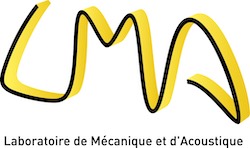Asghar Ali Maitlo
Models of damaged interfaces : mathematical analysis and introduction of stochastic effects
Abstract : Since people began to construct composite structure their main effort was to avoid failure. Damage at the interface of the composite structure is one main cause for the macroscopic failure of the structure. In recent years adhesive bonding technology is widely employed in engineering structural assembly and especially in aeronautics industry, where the use of composite materials is necessary to lighten structures.
Due to the presence of the adhesive layer, adhesive bonding joints are subjected to a complex state of stress with high stress concentrations and, consequently, accurate analysis and modeling of adhesive materials and bonded joints are required. Because the adhesive layer is usually soft and very thin when compared with the characteristic dimensions of the structure, a relatively large number of elements in the thickness direction is necessary to achieve suficiently accurate calculations in standard existing finite element codes. This gives rise to a large number of degrees of freedom and high simulation costs. To successfully deal with this dificulty, interphase modeling has to precede the computation of the numerical solution. A classical modeling approach consists in describing the adhesive as a distinct lower-dimensional continuum, i.e. a material surface. To obtain this material surface, a classical methodology consists in the study of the convergence towards zero of one or more small parameters (the thickness of the bond, its mechanical characteristics, etc.) in the PDE’s describing the equilibrium of the structure. When the adhesive layer is cracked, it is possible to take into account in the model as a damage parameter the local average length of the cracks. However, the distribution of cracks is clearly non-deterministic, it is necessary to introduce stochasticity in the models. Thus It is extremely important in particular to control the damage between the fiber and matrix.
Precise models of damaged interface are thus necessary to properly design
structures and introduction of stochastic effects pay the way to understand
realistic evolution of damage in the interface. Deep investigation and understanding
of damage evolution will enable us to construct robust and stable
structures. In this presentation I will discuss on "A Multi-Scale Model of Soft
Imperfect Interface with Nonlocal Damage" and "introduction of stochastic
effects in adhesive evolution", also "introduction of stochastic effects in adhesive
evolution with temperature effects considerations".
Erik Petersen
The tonehole lattice cutoff frequency : results from theoretical, numerical, and experimental studies
Abstract : The tonehole lattice cutoff frequency is a characteristic of many woodwinds that is generally assumed to be linked to the \musical personality" of a given instrument. For frequencies below the cutoff, the input impedance peaks have large amplitudes and regular spacing in frequency, while the peaks above the cutoff are attenuated and often irregularly spaced. An approximate cutoff of an instrument is often identified as a perturbation in the magnitude or phase of the input impedance that separates these two frequency bands. A precise definition of the cutoff exists only for infinite, loss-less lattices, and has been worked out for the cylindrical resonators. In this talk, the tonehole lattice cutoff frequency is examined from several standpoints.
First, the theory of the tonehole lattice cutoff and a discussion of the mea- surable consequences will be brie y reviewed. This will make the distinction between geometric and acoustic regularity, which is a motivation for applying the theory of wave propagation in periodic media to systems that are a priori not strictly periodic, such as the clarinet. It also allows the theory of cylindrical resonators to be generalized to conical resonators. The second part of the talk will present the results of digital synthesis in evaluating the effect of the cutoff frequency on the sound production of clarinet like resonators. The synthesis is performed on three resonators that are designed to have different cutoffs, and the resulting waveforms are analyzed in terms of spectral content, attack time, and radiation. Finally, the effect of the cutoff on radiation is measured experi- mentally in an anechoic chamber. Transfer functions between internal pressure and pressure at multiple external locations demonstrate the strong in uence of the cutoff on radiation properties of the resonators. These results compare favorably with simulations, but also present questions that lead to future work on the topic of radiation.


